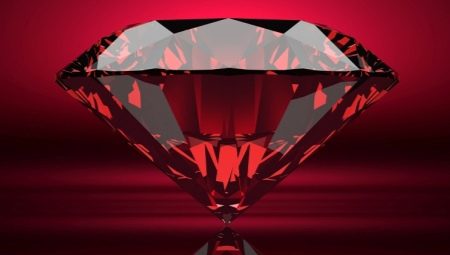Rubies are beautiful natural blood-red minerals. Iron ions give a rich shade to the gem. Crystal sizes reach 400 carats, and their physical properties literally make prices "jump up" in the vast jewelry market. There are many varieties of gemstone, which differ in structure and shades.
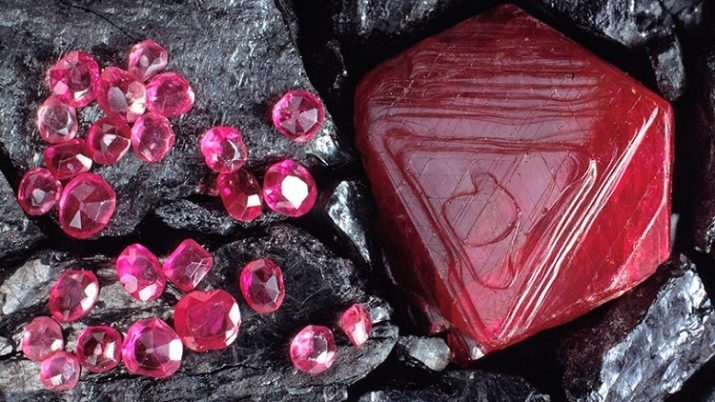
Origin history
The first appearance of ruby is documented in Indian texts in the 4th century BC. e. The mineral is designated as ratnaraja - "gem" in translation from Sanskrit. In historical reports, it was called a talisman, guaranteeing its owner a calm and safe life. Ruby immortalized its juicy blood-red tint, thanks to which it was equivalent to diamonds.
In Burma, a gem was mined on a large scale. People believed that it should be placed under the skin to protect the soul and body. If the ruby became part of the flesh of its owner, then, according to legend, he could protect the owner from the sword and arrows. Often jewels were written in the Bible, where they described the gem as perfection. In Asian countries, it was believed that ruby is a drop of dragon blood. Because of this comparison, it was used as a remedy for the plague and a ward against ailments.
In ancient Russia, sapphire and ruby were often confused, calling both stones yachts. The stones were distinguished only by color.
The modern definition of ruby was given by the Swedish mineralogist Valerius in the 18th century.

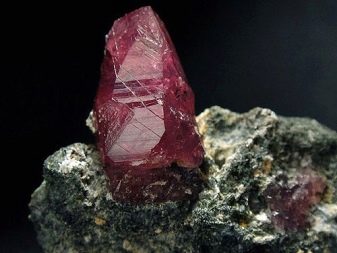
Description and meaning
A real ruby looks like a solid red mineral.The natural substance is turbid, has an asymmetric shape with many small protruding crystals. The surface of the mineral substance is silky to the touch. It contains blotches of milky color.
After processing, the gem acquires a dark red hue, becomes transparent and smooth. Corundum is included in the exclusion group: polished stone has a soft pink tint with purple tints.
The faceted ruby is hard and very heavy. Its regular smooth shape has a high light transmittance. The gemstone has no external or internal defects. There are no cracks or voids in the center of the mineral.
For man, ruby remained a symbol of love, beauty and wealth.
It is believed that the stone awakens a craving for life, protects the owner from lies and supports health.
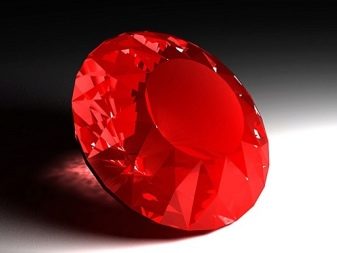
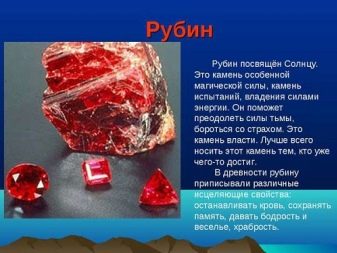
Place of Birth
Gemstones are mined in different parts of the world, with the exception of Antarctica. But rubies of the highest quality are found in Asia. The main exporters of the "bloody" mineral are Thailand, Sri Lanka, Cambodia, Pakistan, Pamir, Tajikistan, Myanmar. Smaller but more unusual specimens are found in East Africa: Kenya and Tanzania.
The latter delivers gems from Vinza. Small crystals are mined in this area, the sizes of which rarely exceed 2-2.5 carats. At the same time, despite their low weight, they have high transparency and no internal damage. After jewelry processing, they have a dazzling brilliance, thanks to which they are highly appreciated in the market.
In Russia, rubies are almost never found. Rare stones can be found in the Polar Urals. They are mined as related material in corundum deposits.
The most common are artificial rubies. Synthetic stones are made of molten corundum with the addition of chemical impurities. In large quantities, such production is recorded in the UK, USA, France, Germany.

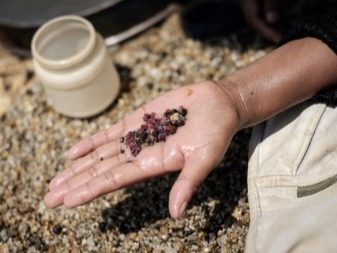
Varieties
People began to mine rubies at the turn of the Bronze Age. They weighed only 35 carats, but even then they had high quality and rich bloody color. Due to its natural beauty, red stones adorned the leaders and kings, they were soldered into jewelry and revered.
The price of rubies remains high, because almost all gem deposits have been depleted and gems have become rare prey. Lower cost is observed in the ennobled minerals that jewelers fill with glass. This procedure is not considered falsification and is regulated by the International Jewelry Confederation.
The most expensive type of "bloody" mineral is a ruby called "pigeon blood" - a gem of a bright red hue with a purple tint. The name of the rare mineral was invented by the Swiss gemologist. The scientist noticed the similarity of the first drops of blood dripping from the beak of a dying bird with the color of a natural mineral.
There are instances of dark red that are mined in Myanmar or Burma.
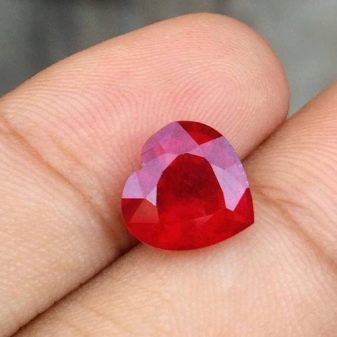

The largest ruby in the world was found in Greenland. Its weight is 440 carats. The stone remains unprocessed, so it is not yet recognized by modern society. After cutting, the mass of the jewel will be, according to preliminary estimates, 380 carats. The king of rubies is considered a Burmese specimen weighing 400 carats.
There are star-shaped rubies that are not distinguished by a deposit or a rare shade - in the center of the processed gem is a shining six-pointed star. This phenomenon has received a separate name - “the effect of asterism”. Often such minerals remain opaque, but minerals with high light transmittance are found. The cost of the latter on the prairies of the jewelry market increases by 2-3 times.
High-quality star ruins are mainly supplied by Asian countries: Vietnam, Burma, Thailand.Some of the jewelry brought from Sri Lanka. In rare cases, in a star ruby, you can find a dual star with 12 rays.
Such stones are considered priceless.

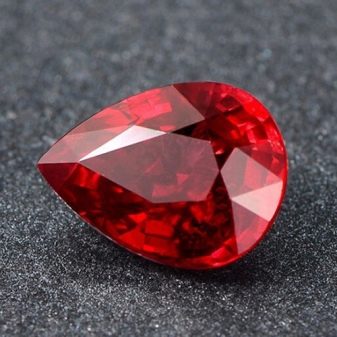
In addition to star rock, there are other interesting varieties of gem in the world. One of them - an anolyte - has an intricate structure of green zoisite with ruby inclusions. The latter are distinguished by a rich pink or red tint.
A unique combination of colors creates beautiful patterns, thanks to which the stone is in high demand at auctions and the jewelry market. Anionites are found only in one place on the entire planet - in Tanzania (Africa). The extraction of rare jewelry is not able to satisfy all buyers, so fakes can often be found on the market. You can avoid such a pattern when reading the documents of the gem. If the field is not indicated on paper and it is sold at a low price, you should be wary and refuse to purchase it.
Black rubies are a kind of spinel. Their market value is not as high as that of real igneous minerals. Black spinel can be seen on the crown of the British Empire.
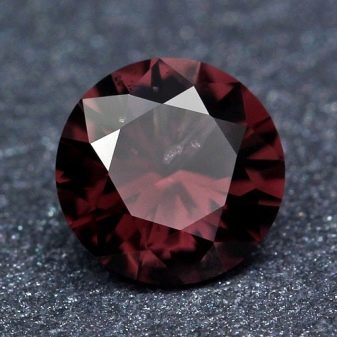

The properties
Before purchasing a ruby, it is recommended that you familiarize yourself with its natural characteristics and beneficial properties.
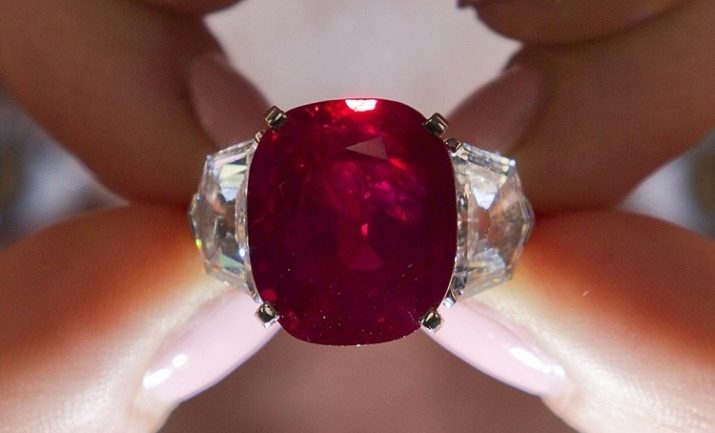
Physicochemical
Ruby belongs to the category of igneous rocks. The chemical formula of corundum is Al2O3. The color gamut usually varies from pink to a blood-red hue, which manifests itself in the mineral structure due to the high content of impurities of iron and chromium oxide. On the Mohs scale, the gem hardness coefficient is 9 points, which is why the ruby is not much inferior to diamonds. Its density is 4-4.05 g / cm³. Corundum belongs to the I class of jewelry. After cutting and grinding, the stone becomes completely transparent.
In rare cases, rutile inclusions may be present in ruby.
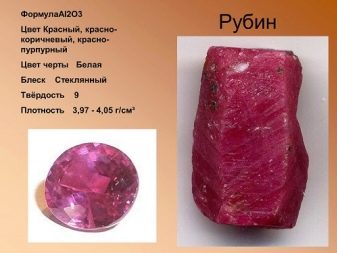
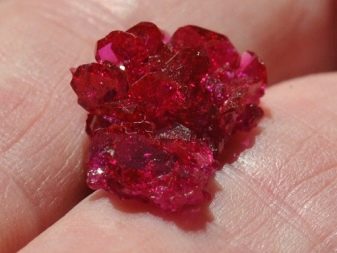
The stone has a number of important physical properties.
- Increased hardness coefficient. Ruby belongs to the group of the most dense minerals. This property is characteristic of almost all magma rocks. Jewel is inferior in density only to diamond crystals. To make sure the stone is strong, drop it from a height onto a hard surface. After a collision with metal or glass on the ruby there will be no damage.
- Color spectrum. Real rubies are red. Hues in different species may vary, but they differ from each other only in color saturation. These are mainly red, burgundy, pink and darkened crystals. Some rubies combine several colors, thanks to which beautiful transitions of different shades of red are created.
- Clear cut of the mineral. Ruby is formed on the basis of magma. Even an uncut mineral is distinguished by clear and even edges on which there are no defects or bends. Due to the high density, jewelers can make the right cuts. The jewel is easy to cut.
- Shine. It creates the false impression that the jewel is covered with gloss. Thanks to grinding, the reflecting and transmitting capacities of the mineral substance increase.
- Glow. Natural stones contain only 2% of metal: chrome and aluminum. The first creates the effect of a purple glow, which can be observed when turning the crystals.
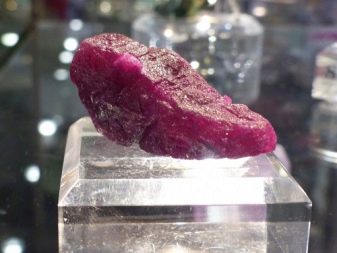
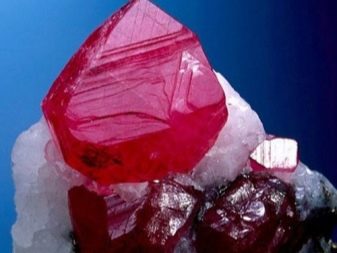
By its chemical properties, ruby does not belong to water-soluble and fat-soluble substances. It does not interact with weak and strong acids, does not decompose in an alkali solution.
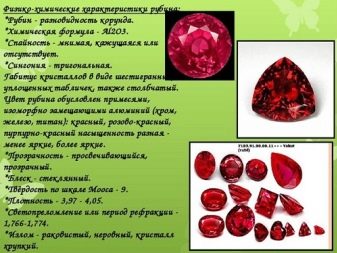
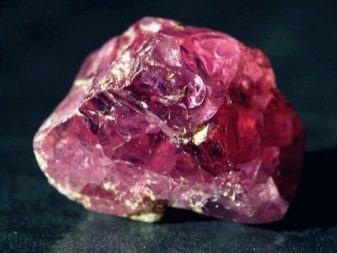
Magical
Ruby helps a man become more confident and brave, gives him energy and protects from evil eye. The jewel makes women more attractive, attracts glances and shows interest in the opposite sex.
The stone according to the zodiac sign promises determination, helps in achieving the goals. Sagittarius ruby allows you to maintain power, gives decisiveness and courage. The "bloody" mineral makes such people more loyal, increases patience, eliminates vanity. Cancer jewel helps eliminate modesty, suppresses shyness.
Rubies give them the opportunity to believe in their own strength.

Due to its magical properties, stone is often used to create talismans and amulets. They have the following qualities:
- protect the owner from impairment, another's harmful intent and the negative effects of envy;
- enlightens the mind, gives its owner peace of mind, improves the psycho-emotional state and increases resistance to stress;
- contributes to the achievement of success in work, victory over competitors and the realization of a dream come true;
- helps to find strong love, maintains passion in relationships for a long time;
- eliminates anxiety, doubt, suppresses uncertainty and anxiety;
- helps to get rid of infertility, creates strong family ties;
- allows the owner to gain wealth;
- relieves of negative feelings, improves mood.
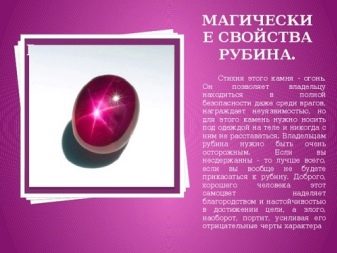
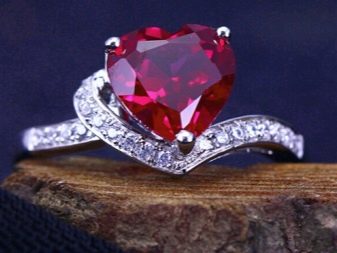
Before purchasing, remember that the jewel is not for everyone. The magical properties of the stone help strengthen the innate qualities of a person: both bad and good.
For this reason, ruby should be worn by people who do not conceal malicious intent.

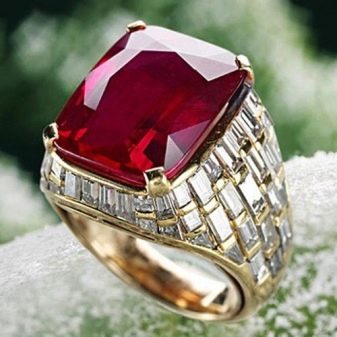
Medical
Ruby is not only a jewel for jewelry. Mineral stone is distinguished by medicinal properties that allow you to cope with various diseases. The "bloody" crystal helps in the following cases:
- eliminates diseases of the digestive system: facilitates the condition with ulcerative erosive lesions of the gastrointestinal tract, relieves inflammation of the stomach wall, reduces the risk of internal bleeding;
- helps to get rid of epilepsy attacks, reduces their threat to the life of the owner;
- increases visual acuity;
- normalizes the work of the cardiovascular system, improves the elasticity of arteries and veins;
- eliminates inflammation of the pharyngeal tonsils, helps with colds and acute infections of the respiratory system;
- has a positive effect on joints, eliminates arthritis and pain;
- relieves the condition with damage to the spinal column, hernias, diseases of the musculoskeletal system;
- relieves diseases of the hematopoietic system, lowers high blood pressure;
- normalizes the functional activity of the central and peripheral nervous system;
- improves the conductivity of nerve impulses, eliminates negative emotions and normalizes hormonal levels;
- relieves sleep disturbances: drowsiness or insomnia;
- relieves physical and emotional stress in the presence of constant stress.

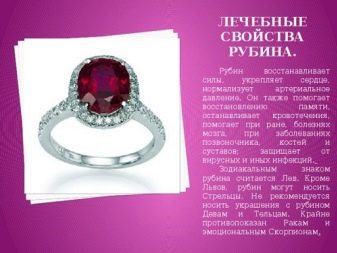
In acute pain, it is recommended to apply a gem to the affected area. The gem helps stop depression and apathy due to its natural ability to pick up negative emotions and improve mood.

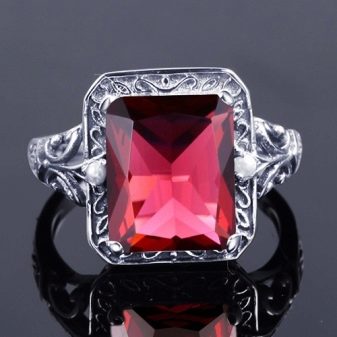
Who is it for?
Ruby is usually worn by people who know how to manage well and have strong tenacity. A gem helps them achieve their goals. At the same time, the mineral is not suitable for conceited, cowardly and weak-minded people.
The "bloody" gem is a great helper for women seeking understanding and love. It helps to take the first step, inspires confidence and eliminates failures. If the owner’s intentions remain sincere and pure, then the jewel will become a powerful talisman for such people. The stone is suitable for the following signs of the zodiac:
- Lions
- Aries
- Sagittarius.
Most people born under these signs have a temperamental hot-tempered character and strong willpower.Ruby is not suitable for emotional and vulnerable Pisces and Libra.
When they wear a gem, the mineral suppresses their character.
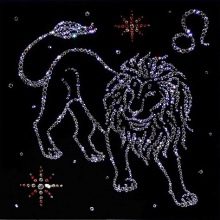
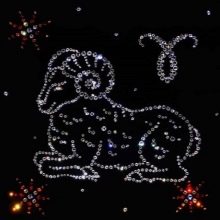
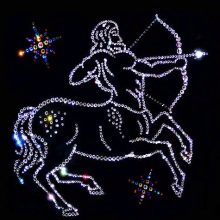
Scope of application
The gemstone is an excellent amulet for doctors and people who are in danger: police, military, firefighters. Talismans with rubies often warn of an approaching disaster: the mineral dims or acquires a more saturated bloody color. Rumor has it that rubies can protect people from natural disasters, damage or the evil eye.
If the house has red crystals, then there will be no fire in the house, they will not rob it, they will not attack the owners of the apartment. With the constant wearing of an amulet with a precious stone, a person will always be lucky. The financial industry, career and health will improve.
Talismans surround the owner with positive energy, give him more opportunities, warn of dangers. Such an amulet helps people with creative professions, accompanies adventures and improves performance. In some cases, a precious mineral can give prophetic dreams.
If a person dreams of a ruby, then in the near future prosperity and successful endeavors await him.
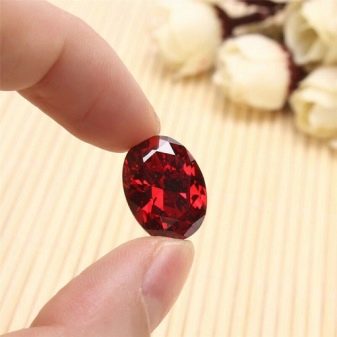
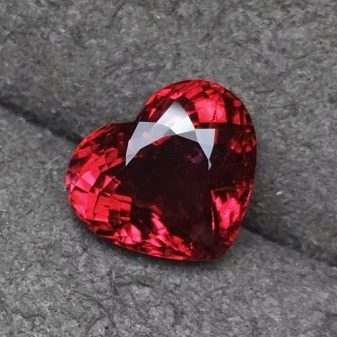
But most often I use ruby when creating jewelry. He becomes the central stone in:
- rings;
- bracelets;
- necklaces;
- earrings;
- necklace.
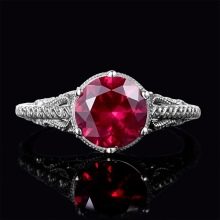
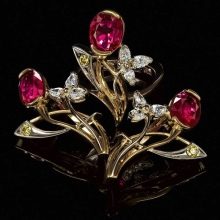
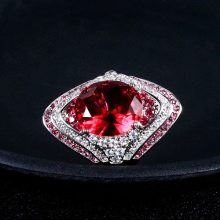
Rubies in silver look beautiful. Noble metal improves the properties of the gem. It is recommended to purchase sophisticated jewelry with rubies. Massive rings look worse.
In addition to jewelry, watches are made from rubies. Artificial stones are inserted into some products. They are of low quality and quickly destroyed.
In order not to accidentally purchase a fake, you must learn to distinguish natural minerals.
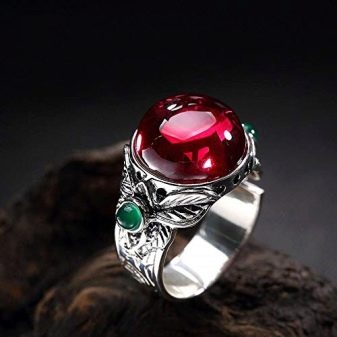

How to distinguish from a fake?
In the jewelry market, up to 70% of precious stones are fakes made of glass, various mixtures of mineral components or alloys. To purchase a natural ruby, there are several ways to recognize a script or a fake:
- if you lower the gem in a glass with milk, the liquid turns pink;
- "Bloody" mineral practically does not heat up from body temperature and remains cool;
- natural crystals may have natural dull zigzag cracks;
- under ultraviolet light, fake products acquire an orange tint;
- there are no air bubbles in the structure of natural stone.
A real gem in the sun shows a purple glow.
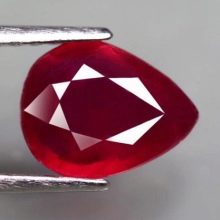
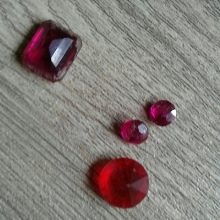
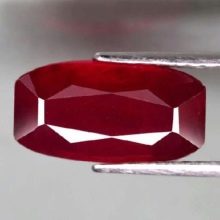
Differences from other stones
Often, ruby or its varieties in jewelry is replaced with more affordable analogues. For such purposes, use such semiprecious stones as tourmaline, pomegranate.
Ruby is significantly more expensive in the jewelry market, but pomegranate is similar to the “bloody” mineral in color. Distinguishing them is quite simple: pomegranate does not have a glossy sheen. You should bring the decoration with a fake to the lamp or look through it in the sun. Grenades give a matte glow, which is fundamentally different from the purple overflow on a ruby. Also, garnet does not have the property of being magnetized. For verification, it is recommended to put the item to be checked on the scales and bring a magnet to it. If the sample increases the pressure on the device and its weight rises, then this is a fake.
Tourmalines come in bright red or pink. When exposed to or under the influence of ultraviolet light, they acquire a red tint. Ruby does not change his color.

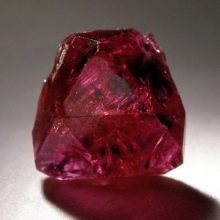
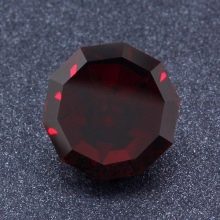
Gemstone differs from cheap glass jewelry by high strength, lack of shine and more saturated color. Also, their differences are visible in price: fakes are more affordable. Difficulties arise when comparing a natural mineral with an alloy of glass and ruby. To create such a mixture, chips from igneous rocks are used. Crumbs and dust are mixed with sand, heated. To distinguish a fake from a natural stone, it is recommended to take the jewel for evaluation to an experienced jeweler.
Aniolites are often confused with green sapphires. Compared to ruby, these gems have a wide range of shades: pink, blue, yellow. The chemical structure of both minerals is the same. At the same time, unlike anolytes in sapphire, there are no red inclusions of ruby crumb.
Diamonds are valued higher in the jewelry market than rubies. They have a higher density and are completely transparent.
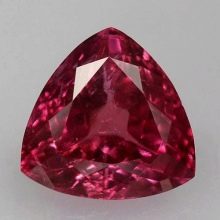
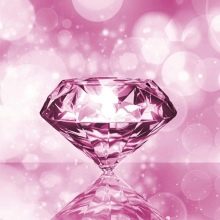
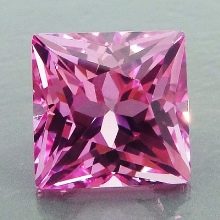
Care
Many people with a precious stone are wondering how to properly care for a ruby, because in case of untimely processing, the mineral may fade, and any mechanical damage can lead to the formation of cracks inside the stone and depreciate it.
The outer faces are high in density, therefore they cannot be scratched or chipped without additional force. On the Moss mineral hardness scale, stone is second only to diamonds and moissanite. Ruby does not fade and is not damaged even during everyday use, therefore it is a good choice for decorating the ring.
At the same time, remember that a jewel can easily crack under the influence of a blunt object. It is necessary to know the owners of bracelets and rings, on which the stone strongly protrudes beyond the jewelry.
To avoid damage to the gem, jewelry should be removed before performing household duties.
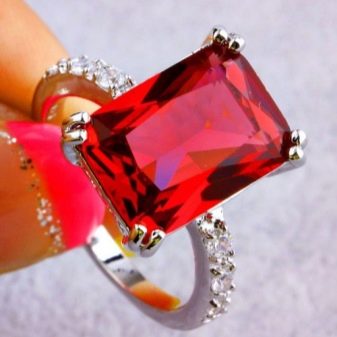
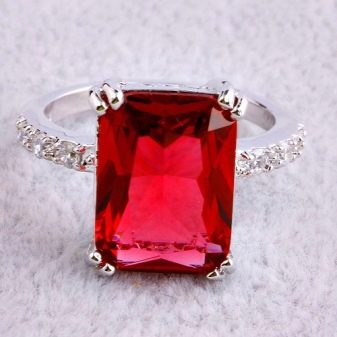
The gem owner needs to learn how to clean the ruby properly. This requires soapy water. During the procedure, you should follow the step by step instructions.
- Place the ruby jewelry in a container filled with warm water. Soap or dishwashing detergent must first be added to the liquid.
- Leave the product to soak for 20 minutes.
- After the necessary time has elapsed, you need to get jewelry, clean the stone with a soft toothbrush or cloth. After that, it is necessary to wash the frame for the gem. It is recommended to use a brush so that the hairs can clean hard-to-reach places in the product. Care must be taken when cleaning the ruby, which is fixed in the jewelry with the help of teeth: usually they are easy to break or the stone can slip out of the grip.
- The basis of the decoration can be wiped with a cloth. It will not scratch or damage soft precious metal.
- After cleaning, rinse the jewelry thoroughly in clean water and dry with a soft cloth.
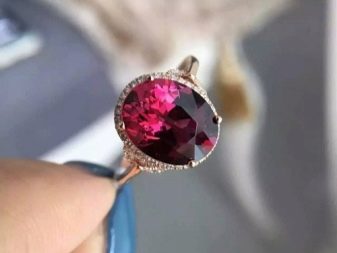
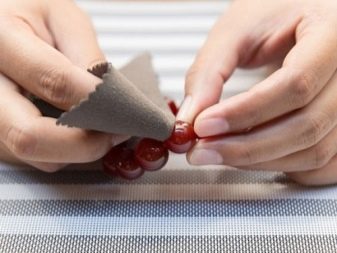
It is allowed to clean the gem with detergent or household chemicals. First you need to make sure that its composition does not damage the mineral structure of the crystal. It is recommended to store the mineral dry. It is advisable to purchase a special jewelry box for keeping the gemstone.
Pre-wrap the mineral in a soft cloth or plastic bag: ruby can be scratched by other jewelry with dense stones, such as diamonds. But often the opposite happens: due to its high density, a "bloody" stone easily damages other gems and soft metal products.


You can learn about the magical properties of ruby by watching the video below.
